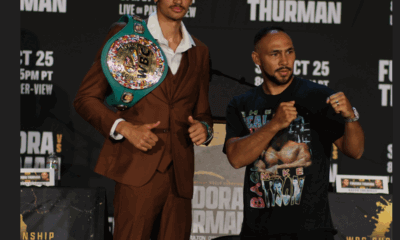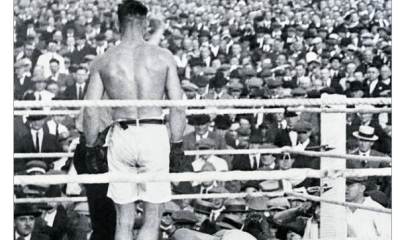Asia & Oceania
Age, Bad Judging, and Jeff Horn Beat Manny Pacquiao
THE HAUSER REPORT — On Sunday, July 2 (Saturday night in the United States), Manny Pacquiao and Jeff Horn met in the ring at Suncorp Stadium in Brisbane, Australia, before 51,052 fans to battle for the WBO welterweight title.
Pacquiao, who entered the ring with a 59-6-2 (38 KOs) record, is no longer the force in boxing that he once was, either as a fighter or a commercial attraction. Five years ago, Juan Manuel Marquez left him lying face-down on the canvas. One punch in a fight that Marquez was losing turned Manny’s world upside down.
Pacquiao has had seven fights since then, highlighted by an embarrassingly lethargic outing against Floyd Mayweather in 2015. The last knockout he scored was thirteen bouts and eight years ago. Still, entering the ring to face Horn, Pacquiao was widely regarded as a quality fighter. He was good enough last year to outclass Tim Bradley and Jessie Vargas en route to unanimous-decision triumphs.
The 29-year-old Horn (16-0-1, 11 KOs) wasn’t seen as much of a threat to Pacquiao. He’d never fought professionally outside of Australia and New Zealand. The only recognizable names on his record were Ali Funeka and Randall Bailey, both of whom were years removed from their prime and have not won a fight since Horn fought them.
There was the usual pre-fight hype. Freddie Roach (Pacquiao’s trainer) told the media, “I have not seen this Manny Pacquiao in seven years. He reminds me of the old days, of the Manny who fought Ricky Hatton, just destroying them.”
Pacquiao, for his part, declared, “”In all my years of boxing, I have never been as motivated and fired up as this fight.”
That led to the question of why Manny was more “motivated and fired up” to fight Jeff Horn than to fight Floyd Mayweather. But no one was taking his comments seriously.
Meanwhile, Horn’s trainer, Glen Rushton, told the media that he had a “secret ten-point plan” to beat Pacquiao.
“I can get the job done if I follow it one hundred percent,” Horn said.
Pacquiao was a 5-to-1 betting favorite.
The night began on an inauspicious note for ESPN (which televised Pacquiao-Horn in the United States). A Major League Soccer game ran longer than expected and delayed the start of the telecast by four minutes.
Joe Tessitore, Teddy Atlas, and Tim Bradley called the action from ringside backed in the studio by Steve Levy and Stephen A. Smith.
ESPN’s telecast opened with Shane Mosley Jr. (10-1, 7 KOs) vs. David Toussaint (10-0, 8 KOs). Suffice it to say for the moment that Shane Mosley Jr is to Shane Mosley as Frank Sinatra Jr was to Frank Sinatra. Toussaint won a narrow split decision victory in a boring fight.
Next up, Irish Olympian Michael Conlan (2-0, 2 KOs) was matched against Jarrett Owen (5-4-3, 2 KOs). The five guys Owen beat had a composite ring record of 4 wins in 30 fights, and he’d been knocked out by a fighter named Haruki Noma (who never won another fight). In other words, the result of Conlan-Owen was preordained. Owen entered the ring expecting to lose and did, on a third-round stoppage.
IBF junior-bantamweight champion Jerwin Ancajas (24-1-1, 16 KOs) vs. Teiru Kinoshita (25-1-1, 8 KOs) was the third televised fight of the evening. Tessitore trumpeted the fact that Kinoshita had won his most recent three bouts by knockout. He neglected to tell viewers that the three opponents Kinoshita knocked out in these fights had a composite ring record of 0 wins and 9 losses. Ancajas won on a seventh-round knockout.
That set the stage for Pacquiao-Horn.
Horn came to win, not just survive. He fought aggressively in the early going, abetted by the fact that Pacquiao is now 38 years old with the wear and tear of a 22-year ring career on his body.
Manny’s reflexes have slowed. Against Horn, his timing was off. He no longer commits to the straight left hand like he used to and was unable to counter effectively for most of the night. He cut Horn near the corner of the right eye in round three and did some good body work from time to time. But that was all he did in the first half of the fight, which looked to be even after six rounds.
Meanwhile, Pacquiao’s blood was flowing. He suffered a deep cut on the hairline from an accidental clash of heads in round six and another deep cut above the right eye from a second clash of heads in round seven; cuts that required nine and eight stitches respectively to close after the fight.
By round eight, both fighters were tiring and beginning to lose form in what had become a sloppy bloodbath. But Pacquiao was getting the better of it.
The action peaked in round nine, when Pacquiao pummeled Horn around the ring, prompting referee Mark Nelson to visit Horn’s corner during the one-minute break before round ten and threaten to stop the fight.
But Pacquiao was unable to close the show.
Then came the judges’ decision: Waleska Roldan 117-111, Chris Flores 115-113, and Ramon Cerdan 115-113 . . . All for Horn.
It was a bad decision. Scoring off of television (not as good a view as the judges had), this writer saw it 115-113 for Pacquiao. If one gave all the close rounds to Horn, those numbers arguably could have been reversed. But it would have been a stretch. And 117-111 was beyond the pale of reason.
Teddy Atlas, sitting at ringside, was apoplectic when the decision was announced. “They gave Horn a trophy for trying hard,” Atlas raged. “You’re not supposed to get it for trying hard. You’re supposed to get it for winning.”
Then, after considering his thoughts more fully, Atlas said of Roldan’s scorecard, “It’s only one of two things. It’s either incompetence or corruption. When you see 117-111, I don’t think anyone could be that incompetent. I’m sorry. If you know the sport, you watch the sport, you can’t be that incompetent. So what else could it be? Corruption.”
However, Atlas’s reaction was calm compared to that of Stephan A. Smith.
“It was a bogus decision,” Smith told viewers. “The thing that I’m depressed about right now is that I don’t have the three names and a mug shot of each of those officials for the crime that they committed of robbing Manny Pacquiao tonight. There is no excuse for a decision like this.”
Here, it should be noted that Roldan was party to a similar miscarriage of justice three years ago when hometown favorite Heather Hardy was awarded a horrible split decision over Jackie Trivilino at Barclays Center in Brooklyn on the undercard of Ruslan Provodnikov vs. Chris Algieri. That decision was so bad that Hardy’s hometown crowd erupted in boos when it was announced.
More recently, Roldan was one of the judges involved in the injustice visited upon Roman Gonzalez when she scored his March 18, 2017, fight against Srisaket Sor Rungvisai a draw. The other two judges were even more off base, scoring that bout for Rungvisai.
But the fights were only part of the story on Saturday night. In some ways, the telecast was reminiscent of the March 7, 2015, offering on NBC that featured Keith Thurman vs. Robert Guerrero and Adrien Broner vs. John Molina Jr. On that night 28 months ago, the big story was the launch of Al Haymon’s Premier Boxing Champions. Similarly, July 1 was the opening salvo in a new venture by Top Rank (Pacquiao’s promoter) and ESPN.
While no formal announcement of long term plans has been made, reports suggest that:
(1) Top Rank fights will be televised in the United States exclusively on ESPN, ABC, and a new ESPN OTT streaming video subscription channel.
(2) The new technological platform will be built by BAMTech (a technology company that specializes in video streaming and helped build HBO Now).
(3) As reported by Sports Business Daily, the direct-to-consumer offering will carry the ESPN brand and is expected to launch this fall. Revenue will be generated through a combination of subscriptions and advertising. Programming will feature niche sports, including boxing. Initially, all programming will be original and will not be simulcast on ESPN.
(4) The Top Rank and ESPN film libraries (the latter includes what was once Bill Cayton’s Big Fights library) will be pooled for various projects.
(5) In addition, Top Rank might have access to a third-party venture capital fund that will provide financial assistance for the signing and development of fighters.
No one at Top Rank or ESPN is talking about the details of the agreement. And Pacquiao-Horn would have been an ideal time to announce it. This gives rise to the belief that there are some “I”s to be dotted and “T”s to be crossed before everything is finalized.
Be that as it may, ESPN and Top Rank have announced two more fight cards to be contested in August: (1) Vasyl Lomachenko vs. Miguel Marriaga and Raymundo Beltran vs. Bryan Vasquez on August 5; and (2) Terence Crawford vs. Julius Indongo and Oleksandr Gvozdyk vs. TBA on August 19.
As for Pacquiao, his age is showing.
Tris Dixon recently wrote of Manny, “We judge him by the standards he has set. And they are incredibly high.”
But Pacquiao can no longer meet those standards.
Thomas Hauser can be reached by email at thauser@rcn.com. His most recent book – A Hard World: An Inside Look at Another Year in Boxing – was published by the University of Arkansas Press. In 2004, the Boxing Writers Association of America honored Hauser with the Nat Fleischer Award for career excellence in boxing journalism.

Check out more boxing news on video at The Boxing Channel
-

 Book Review4 weeks ago
Book Review4 weeks agoMark Kriegel’s New Book About Mike Tyson is a Must-Read
-

 Featured Articles3 weeks ago
Featured Articles3 weeks agoThe Hauser Report: Debunking Two Myths and Other Notes
-

 Featured Articles3 weeks ago
Featured Articles3 weeks agoMoses Itauma Continues his Rapid Rise; Steamrolls Dillian Whyte in Riyadh
-

 Featured Articles3 weeks ago
Featured Articles3 weeks agoNikita Tszyu and Australia’s Short-Lived Boxing Renaissance
-

 Featured Articles4 weeks ago
Featured Articles4 weeks agoKotari and Urakawa – Two Fatalities on the Same Card in Japan: Boxing’s Darkest Day
-

 Featured Articles3 weeks ago
Featured Articles3 weeks agoIs Moses Itauma the Next Mike Tyson?
-

 Featured Articles2 weeks ago
Featured Articles2 weeks agoBoxing Odds and Ends: Paul vs ‘Tank,’ Big Trouble for Marselles Brown and More
-

 Featured Articles2 weeks ago
Featured Articles2 weeks agoAvila Perspective, Chap. 340: MVP in Orlando This Weekend




















